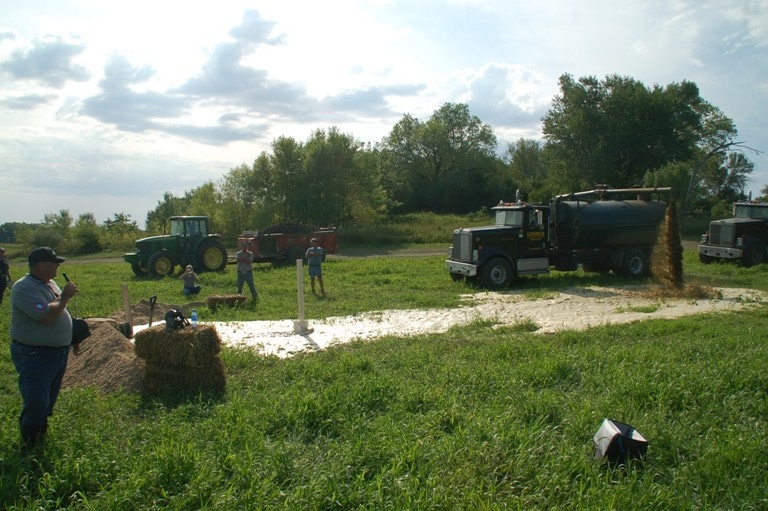With a Department of Natural Resources inspector standing close at-hand, a manure tanker hose opened up and sent streams of liquid manure cascading down a hill in a Wisconsin field as part of a dramatic manure spill response demonstration at the recent North American Manure Expo near Prairie du Sac, WI. The purpose of the demonstration was to provide hands-on training to Expo attendees on ways to deal with a serious manure spill.

With a Department of Natural Resources inspector standing close at-hand, a manure tanker hose opened up and sent streams of liquid manure cascading down a hill in a Wisconsin field as part of a dramatic manure spill response demonstration at the recent North American Manure Expo near Prairie du Sac, WI. The purpose of the demonstration was to provide hands-on training to Expo attendees on ways to deal with a serious manure spill.
Nutrient management professionals urge producers and professional nutrient applicators alike to remember the “Four Cs” if the worst happens and they are faced with an emergency spill:
Step 1: Control-eliminate the source of the manure spill.
Step 2: Contain-limit the area impacted.
Step 3: Comply-assess and report damage to the proper authorities.
Step 4: Clean up-restore the affected area.
The Iowa Farm Bureau and Iowa Manure Management Action Group (IMMAG), provide additional details about the Four Cs. In the case of a manure release that occurs during application, applicators should stop application immediately and shut off manure pumps. If an umbilical hose ruptures, park a tractor or other heavy equipment on both sides of the break. Once the flow of manure has been stopped, the spill must be contained to protect environmentally sensitive areas. Iowa State University publications note that even in an area with less than 2% slope, manure can flow at speeds of up to 5 ft./second. How the applicator reacts during the first 5 to 30 minutes will determine the eventual impact of the spill and can make a difference when it comes to any possible penalties.
Officials at the North American Manure Expo demonstrated ways producers and applicators could create dams with hay or straw bales to help slow the manure’s spread. Five-gallon buckets, PVC pipe, plastic sheets and plywood are some examples of items that can be used to help plug tile outlets and cover tile inlets in the event of a spill. If the spill is sizeable, using tillage equipment to stop the manure’s movement toward vulnerable waterways may be necessary. Using sand or other materials to soak up or slow the manure’s spread can also be a containment option.
Experts recommend assembling a manure spill response kit to have ready and accessible on the farm when pumping and applying manure. The kit should include:
1. A copy of the farm’s emergency response plan, including emergency numbers and a site map;
2. Hay or straw bales that could be used to block a culvert or build a berm or diversion;
3. T posts to support plywood or bale stacks;
4. 14-in. diameter PVC pipe in both 3-ft. and 2-ft. sections that could be used to cover tile inlets;
5. Several 6-mil. plastic sheets of approximately 12-ft. x 25-ft. lengths that could be applied to tile inlets or other sensitive areas with duct tape;
6. At least one sheet of 4-ft. x 4-ft. plywood that could be used to block culverts. Round the plywood on one end to fit the curve of the ditch;
7. Pliers, vice grips, fencing pliers, channel lock pliers, hammers, utility knife, hand saw, hatchet, post driver;
8. 1 roll duct tape;
9. Baling wire; and
10. Sand shovels.
At the minimum, nutrient management experts recommend that a mini-kit that could be kept in the truck or tractor. The mini-kit should contain a sand shovel, duct tape, utility knife and 6-mil. plastic sheets.
Ideally, the Department of Natural Resources (DNR) should be contacted as soon as possible after the spill. Part of the DNR’s job is to help producers and applicators respond efficiently and effectively to the spill. When notifying the DNR, be prepared to provide information about the location, time, and estimated amount and source of the manure spill. Let the DNR know about any water resources that have been or could be impacted by the spill.
Clean-up plans should include provisions for emergency pumping and land application of the manure, even when field or crop conditions would not normally be considered right for application. Experts suggest discussing restoration and clean-up plans with the DNR, and obtaining written authorization of the clean-up plans from the DNR representative.
About the Author(s)
You May Also Like



